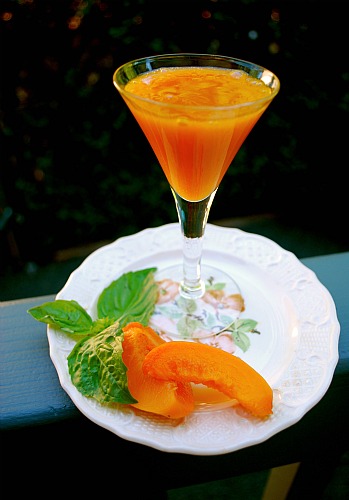
~ Apricot Nectar ~
I happen to love this stuff. I grew up drinking it out of cute little cans. I remember when I was a kid it would show up once in awhile in our pantry or fridge. It was considered a special occasion treat for us, so I remember sipping it a tiny bit at a time, to make it last as long as possible.
I recently made it from scratch and I'm so glad I did. Taking the time to make it from scratch took Apricot Nectar to a whole other level.
First, here are a few facts: it's made with fresh apricots, so it contains hefty amounts of vitamins A, C, E, potassium, and iron, as well as being a great source of beta-carotene. In fact, 2-3 apricots will give you nearly 50% of your daily value of Vitamin A.
Fresh apricots contain no fat and a small amount of carbs (about 8g of carbs for two apricots, 2 of those being from dietary fiber) and let's not forget bonus points for being so satisfying.
The following is a step-by-step tutorial about making Apricot Nectar.
~~~~~~~~~~~~
This is what 18 pounds of apricots look like in the top portion of my vintage steam juice extractor.
IMPORTANT NOTE: The apricots do not need to be pitted or cut into pieces! I am not sure why I prepped them first, but the other batches and did whole with the same results.
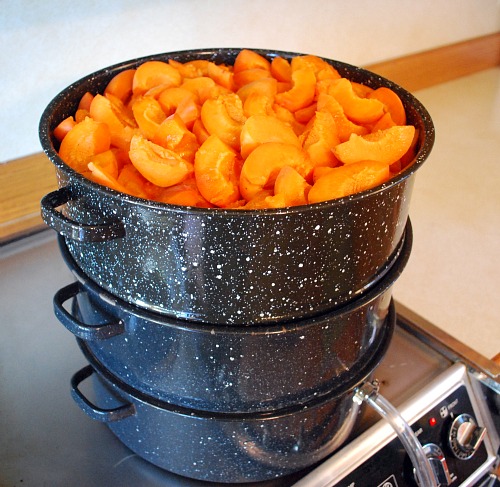
Before we go further I need to confess something: I have no fear of sugar. I'm pretty sure I couldn't live without it on a daily basis. Just letting you know in advance that Apricot Nectar does contain sugar. Otherwise it just wouldn't be the same. Sugar helps to preserve the nectar, and in my opinion, it tastes much better with sugar too!
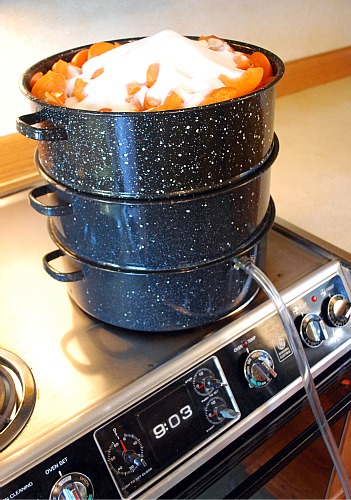
I'm new to this steam juice extractor thing, but I read somewhere that it helps to dissolve the sugar if you pour the first quart jar of juice back over the fruit. It also ensures that the tubing is now sterilized for any of the remaining juice that drains from the steam juice extractor.
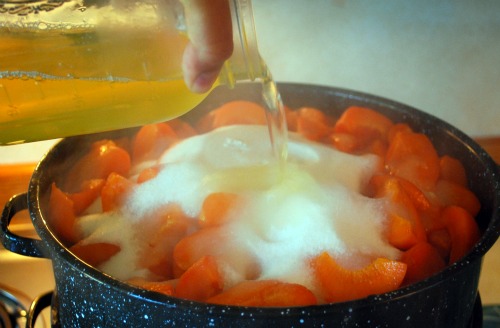
This is what the 18 pounds of apricots look like as they cook down. No Photoshop color-enhancing. They really are this bright and beautiful. Orange is my favorite color and looking at these Apricots makes me very happy.
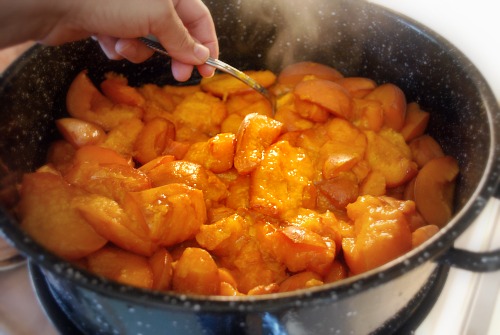
Scoop the pulp into a food mill and crank away. The puree is extruded into the bowl below and the stringy pulp stays behind. It's shocking to see how little pulp is left behind from 18 pounds of apricots. A hand-cranked food mill is very efficient, plus using it burns a few calories!
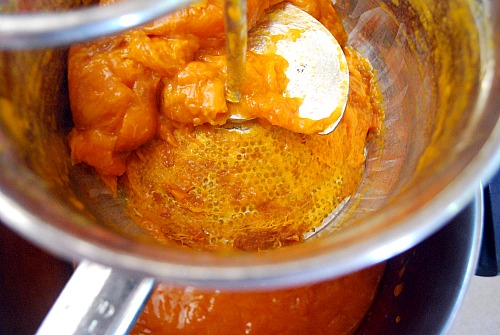
It took about 90 minutes for the steam juice extractor to extract the juice. Then I pureed the cooked-down apricots (that remained in the top portion of the extractor.)
Here's what you end up with:
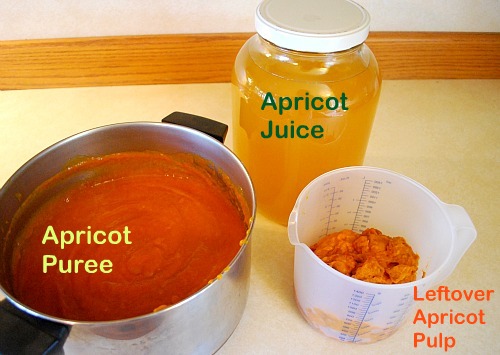
90 ounces Apricot Puree
128 ounces Apricot Juice
(16 ounces Apricot Pulp -- to be composted)
Apricot Puree + Apricot Juice = Apricot Nectar
--> Some canning guides suggest that if you are planning to process the Apricot Nectar, you could (optionally) add 1 TBS lemon juice per quart of nectar, to retain color and increase acidity. You might need to increase sugar to balance out the tartness. The lemon juice is unnecessary if you are planning to consume the nectar immediately or store it in the fridge.
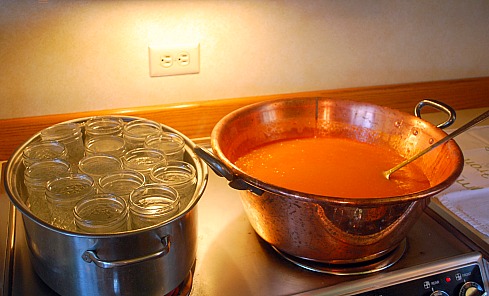
Cook the Apricot Nectar just enough to blend and prepare it for ladling into warm jars (on the left).
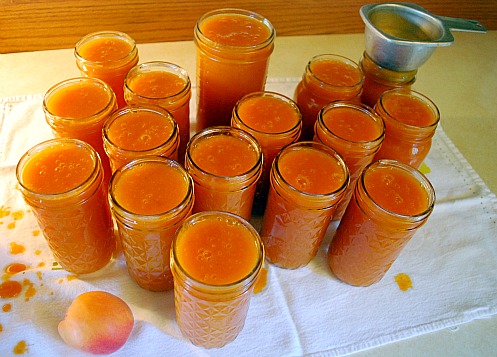
This recipe made a total of 16 jars.
One 20 oz jar, for our immediate consumption.
Three pint jars, for friends and their grandkids. (I'm getting the next generation hooked early.)
And in my pantry? One dozen 12 ounce jars.
This nectar will be great as is, or in cocktails, or added to recipes**.
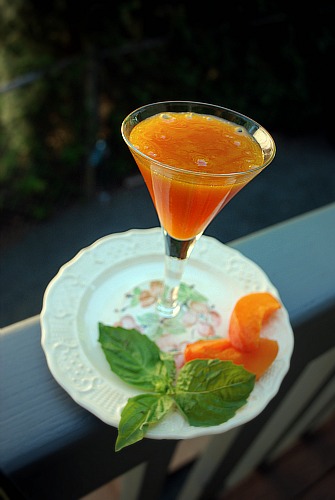
It was definitely worth the time I spent making my own Apricot Nectar. I don't think I can ever go back to popping open those cute little cans ever again. The best part about making a big quantity? No more sipping it slowly out of a tiny tin can. I can guzzle as much as I want. Something tells me I'll have no trouble meeting getting my daily requirement of Vitamin A.
* I used "Perfection" Apricots, from the Wenatchee Valley in Washington State. They are one of my all-time favorite apricots for several reasons. Sure, they are delicious eaten fresh, and are also a joy to preserve, but they photograph so beautifully, which pretty much seals the deal for me. Don't believe me? Here's a blurb I stole from the Okanogan Vacation Guide:
Perfection apricots are an older apricot variety that produces very large fruit, and are very good eaten fresh. A large, round, orange, and very attractive apricot. Perfection apricots ship very well, so if you're traveling home with apricots, these are a good choice. Perfections are very good canned, and in recipes like apricot muffins, apricot filled cookies, apricot pound cake and in dried apricot recipes. You can also use them fresh in apricot salads, and delicious homemade syrups. Perfection apricots are typically available from the end of July to the middle of August.
** Recipes using Apricot Nectar
Apricot Nectar Cake - allrecipes.com
194 results for Apricot Nectar in recipes - COOKS.COM
11 drinks (both non-alcoholic & boozy) containing Apricot Nectar - BarNoneDrinks.com